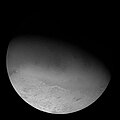Geology
Leviathan Patera is a large, steep-sided depression with a number of arcuate scarps; its general structure strongly resembles that of terrestrial collapse calderas on Earth. The northern half of Leviathan Patera's floor is ~450 metres (1,480 ft) deep and largely flat, though an irregular plateau interrupts the flat floor. In contrast, the southern half of Leviathan Patera is occupied by a broad dome ~400 metres (1,300 ft) high, nearly level with the surrounding plains. The northwestern section of Leviathan Patera is host to a high point approximately 1 kilometre (0.62 mi) in height, one of the highest points in the local region. [2] Leviathan Patera is surrounded by a ring of very smooth terrain that is etched by arcuate alcoves that all face outward from the caldera center. [4] [5] : 888 Leviathan Patera sits near two major tectonic features, Kraken Catena and Set Catena, likely indicating that Leviathan Patera's formation and activity is closely linked to rifting at its site. [6]
Leviathan Patera appears to be the central vent of a massive, geologically young plateau of cryovolcanic material, Cipango Planum. Eruptions of volatile material termed cryolava from Leviathan Patera constructed much of Cipango Planum's edifice and the smooth terrain immediately surrounding Leviathan Patera. Assuming Cipango Planum is a part of Leviathan Patera's cryovolcanic edifice, Leviathan Patera is the largest known cryovolcano on Triton and one of the largest volcanic features in the Solar System. [a] The eruptive history of Leviathan Patera may have occurred in several stages, first erupting low-viscosity cryolava which resurfaced the surrounding plains (possibly accounting for Cipango Planum's very shallow relief), eventually transitioning to explosive eruptions before finally transitioning to erupting higher-viscosity material constructing domes within the caldera. [2] Comparatively little collapse appears to have occurred within the center of Leviathan Patera, and apparent explosion pits surround a ring fracture. [5] : 920
This page is based on this
Wikipedia article Text is available under the
CC BY-SA 4.0 license; additional terms may apply.
Images, videos and audio are available under their respective licenses.

